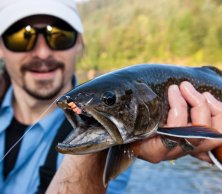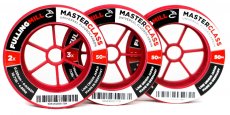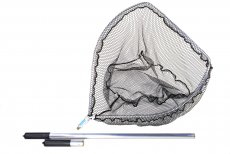A comprehensive guide to the proper equipment of a stillwater fly fisherman and, of course, very useful fly fishing accessories that are absolutely necessary and often play a large part in success when fishing on still waters for trout of all types and sizes!
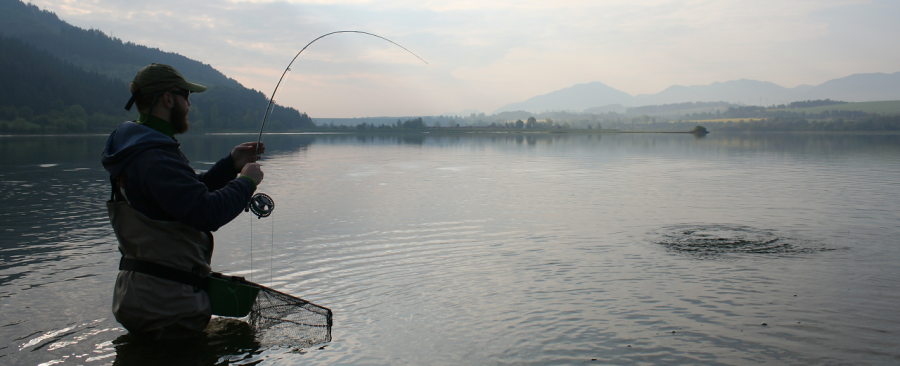
Of course, stillwater fly fishing differs from river fishing not only in terms of fishing tactics and techniques or commonly used artificial flies, but of course also in its own fly fishing equipment, which - due to the fishing conditions and the size of the fish caught - is somewhat "stronger" and more loaded - especially in terms of fly fishing lines and special accessories, which will not find a more meaningful or lasting use when fly fishing on the river!
Considering the categories of commonly used fly rods, fly reels and fly lines, it could be said that trout fishing on still waters already belongs to "moderately heavy fly fishing" - at least in our territory, where "heavy fly fishing" is considered to be fishing for large predators and carp fish - unfortunately, we don't have bigger and stronger fish that would raise the bar even higher!
FLY ROD: I am personally of the opinion that, as with the "heavy fly fishing", we can easily classify it as a universal stillwater fly rod! There used to be opinions (and maybe they still do) that clearly the most versatile fly rod for stillwater trout fishing is the category 796 or 7100 (AFTMA 7 in length 9.6 - 10 feet = 290 - 305 cm).
I do not completely share this opinion - category 7 in combination with a length of 10 feet already seems too much to me - and when I think about the normal weather conditions and the size of the Czech trout still watery + the normal size of the fish living in them, it seems to me more like a category 690 rod a maximum of 696 (AFTMA 6 in length 9 - 9.6 feet = 275 - 290 cm), which can easily handle casting and tackling normally large fish in the considered conditions! And believe me, that opinion is objective, because I usually fish with a category 590 rod myself! 😅
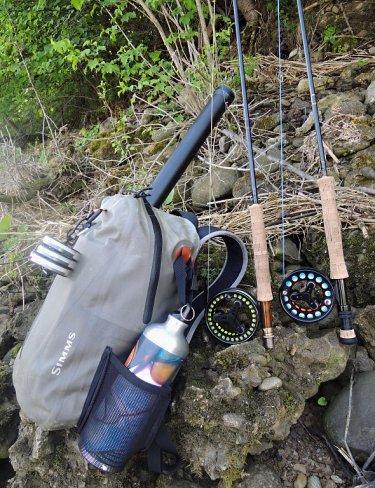
But considering that the action of the rod itself (mostly semi-parabolic to tip of rod), which is always completely unique for rods of the same category - but from another manufacturer - is very important, I will not be so strict! 😉 Therefore, the following models appear to me to be suitable candidates - in the mentioned category 690/696-4 to 796-4:
◼ Fly Rod Hanak Competition Superb SW
◼ Fly Rod Leichi Nano Still Water
◼ Fly Rod Hends CSR Stillwater
◼ Fly Rod Hanak Competition Stillwater X
Of course, slower rods suit some people, and faster ones for others. It also depends on your fly line casting skills - some people are comfortable with a longer rod to help them cast further, some prefer shorter rods, as long ones create too much leverage which tires the hand more quickly, etc. There are lake anglers who prefer a cigar grip over a american grip, others they have exactly the opposite! It's individual!
👉 From my point of view, it is very important that the fly rod for the stillwater is mainly as light as possible, with a medium to fast action (I prefer fast), a maximum length of 9.6 feet (I prefer only 9-foot rods myself), for better transport 4 -partial, it should have a quality cork handle (ideally full wells handle), hard eye-lets made of quality steel that can withstand the impact of long casts and the friction of the fly line. Well, in the case of fishing for big fish on a rod, I very much welcome a fighting but (a cork end), thanks to which I can rest the rod on my forearm and relieve my wrists!
FLY REEL: The right reel for stillwater fly fishing should perfectly balance the fly rod - so it should ideally match its size and weight category. These days, Large Arbor (LA) type reels are absolutely standard - with a wide spool even in river fly fishing sizes! LA reels reduce the shape memory of the fly line, which is why they are both a matter of course and a necessity for stillwater fishing, because if you want to rule the lake with long casts, you cannot be held back by a fly line tangled in small loops that immediately get stuck in the guide eye ring.
A fly reel for lake fly fishing should of course be reliable, ideally with a high-quality disc drag, which will gently control the resistance of the reel in the event of fighting a larger fish "over the reel". Since - as you will learn below - you will need more fly lines when fishing for trout on still water, your ideal stillwater fly reel should ideally have more spools! For the purpose of fishing on the lake, so-called cassette reels were developed, which usually include 3 easily replaceable plastic spools for quick change of fly lines. The Fly Reel Hanak Competition River & Lake is a typical representative of a simple cassette reel! Another great solution are the Waterworks Lamson 3-Pack fly reel systems in Liquid and Remix, where you will find a reel with 3 metal spools in a practical package!
FLY LINES: Quality and special fly lines are absolutely essential and one could say the most important part of a stillwater fly angler's equipment! If you are used to fishing rivers with only a floating line, or if you only use it as a base under a French leader, you should prepare yourself to have to expand your arsenal!
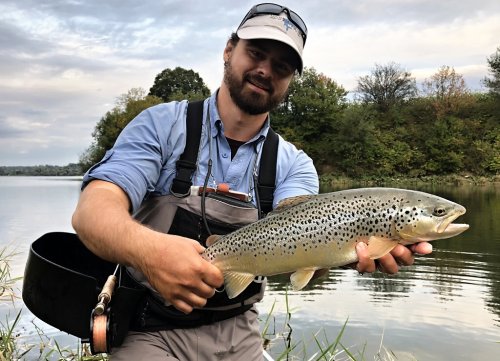
Just like a fly reel, fly lines should ideally match the category and action of your stillwater fly rod! In stillwater fly fishing, basically only extended lines of around 30 m are used, with weight forward WF and different shaping of the heads, which has a major effect on the length of the cast, the smoothness of the line's impact on the surface and the presentation of the flies. A very important feature of the stillwater fly line is the non-stretchable core, thanks to which you will always be in direct contact with the flies and feel even the most delicate shots! The basic and most frequently used lines for stillwater fly fishing include:
◼ Floating fly lines - An absolutely essential type of stillwater fly lines for fishing with dry and wet flies, nymphs, buzzers, but sometimes also lures and streamers... Of course also when fishing "on static" with an indicator or indicator fly. A floating stillwater line should be sufficiently supple and smooth with minimal shape memory. This is the lightest type of stillwater fly line, so it should be of the highest quality so that you can cast with it really comfortably and without any problem reach the desired length of the cast even in worse weather conditions! An excellent type of floating fly line that meets all these aspects is, for example, the Fly Line Floating Guideline 4CAST. Floating lines are usually made in highly visible or natural colors, which are more important for you, because the fish see the line against the bright sky as a dark stripe, which in our area is certainly not disturbed by 95%!
◼ Hover subsurface fly lines - Very slowly sinking fly lines (about 1 cm/sec), which "cut" in the water surface, where they hold very well and, e.g. in waves, rather "float" in the upper part of the water column, which is an excellent feature that you will mainly use when fishing with wet flies, nymphs, but also lures that you want to revive slowly regardless of e.g. strong wind and bigger waves, which you could not afford with a floating line! Hover fly lines are most often made in clear or natural colors, which should be less noticeable to fish, but I dare say that with their visibility to fish against a bright sky, it will be quite similar to floating lines! Personally, this type of subsurface fly line is my favorite and I consider it to be the absolute most versatile type of lake fly line!
◼ Intermediate fly lines - Medium fast sinking lines, which according to their sinking speed are divided into slow (around 2 - 3 cm/sec) and fast (around 4 - 5 cm/sec) intermediate fly lines and are absolutely great for fishing with lures, streamers , but also with wet flies and nymphs in the middle of the water column! It could be said that the intermediate fly lines are therefore universal stillwater lines for faster revival of flies when fishing for fish active in the middle positions of the water column! Nowadays, they are produced in almost all colors - among the most traditional are blue, green, gray, olive, and of course the most popular transparent version must not be missing!
◼ Sinking fly lines - Heavy type of fly lines with different sinking rates/speeds- normally III (S3) - IX (S9) (around 8 - 24 cm/sec). Tungsten powder is added to their sheath, which makes these lines not very long-lasting, usually after 2-3 seasons (depending on the degree of submergence and use) they tend to crack - that's why I personally don't recommend investing too much money in these lines. In practice, this is a "heavy wire", which - thanks to its high weight - casts well and helps you get the flies to the desired depth faster than intermediate lines. Sinking lines are mainly used in stillwater fly fishing when fishing with Booby nymphs near the bottom. The key question is how long you want to wait for them to sink to the bottom and how deep still water you normally fish! Accordingly, choose a line with the corresponding degree of sinking! Personally, I used to mainly use S3 sinking lines, but I gradually realized that there is no time to waste, and that's why my most used "diver" is now S6 sinking lines! For winter fishing on deep reservoirs/songs, I also have an S9 sinking line ready, because in winter I want to fish effectively and not freeze inefficiently and wait for the flies to sink to the bottom to the fish! 😉
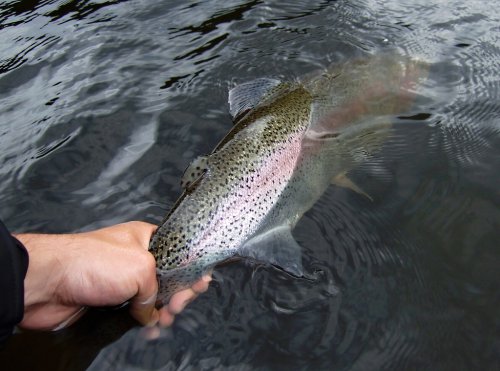
◼ Floating lines with a sink tip (Sink Tip fly lines) - A special type of fly lines also known as Midge Tip (hover or intermediate end) or Sink Tip (sinking tip)! Their main application is when fishing with nymphs from a boat in deep water or in places where the bank slopes rapidly to depth and the sinking end thus copies the underwater slope with the flies where the fish are! These lines are also great in situations where you are fishing in shallow coastal areas densely overgrown with algae, behind which there is already deeper water - you cast the line over this overgrown area, the end part slowly sinks and the floating part lies on the surface covered with algae without it sink into it and tangled. Of course, lines with a sinking tip can be used - depending on the sinking capacity of the end (S1 - S6) - also in ordinary stillwater fishing for lures, boobies, wet flies, nymphs and streamers! If you occasionally wade on lakes, you don't have a stripping basket for the line, which you definitely should, floating running will also come in handy for long casts! 👌
💥 For the purposes of successful stillwater fly fishing, we have prepared for you a universal Fly Fishing Set - Stillwater & Streamer with which you will be fishing for trout on still waters - given that it contains everything important from the basic stillwater equipment - maximally effective!
IMPORTANT ACCESSORIES: In the following list - from my own experience - I have selected very practical products that you can of course do without, but it would be a great shame to omit them, as they are really useful accessories to the main equipment, which will make you more comfortable during stillwater fly fishing, but most importantly it will often help you achieve much better results!
◼ Fluorocarbon tippet - Fluorocarbon have a similar index of refraction to water and are said to make them less visible to fish! But in our conditions - due to the quality and purity of the water in our most popular trout reservoirs - we don't have to worry too much about this. But what I consider to be the more important advantages of fluorocarbon are its: sinkability, smoothness, non-absorption, resistance to UV and especially its stiffness, thanks to which it does not wobble as much as normal softer monofilament lines when casting!
◼ Stripping basket - An excellent helper for the stillwater fly fisherman, both when wading and when fishing from the bank! When wading, it keeps the line out of the water and doesn't sink, allowing you to achieve much longer casts, which is often a key factor in success - especially in waters where the fish are further away! When fishing from the bank, it protects the line from entanglement in branches and grass, which leads to the already described positive - the possibility of longer casts without complications, but thanks to the basket, the line does not even come into contact with dirt (mud, sand), which can very quickly plan a blank and tying the rod! In my opinion, a very practical stillwater MUST HAVE!
◼ Landing net with a long handle - Undoubtedly, another mandatory necessity for a stillwater fly fisherman, you can read about its important features and advantages in my detailed article "How To Choose The Right Landing Net", where you will also find recommended specific types!
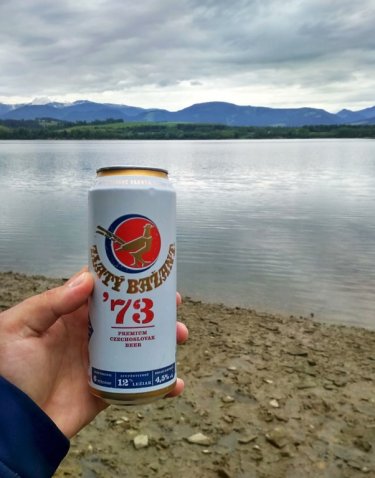
◼ Fly box for a large number of flies - As I already wrote in the related article "TOP Flies For Stillwater Trout", when fishing for trout on still waters you will really need a lot of different fantastic and natural patterns! How about looking for them ideally in one place - in a spacious fly box? Large fly boxes with a center leaf are the right choice!
◼ Degreasing paste - An excellent trick when fishing with a dry fly, or when fishing with nymphs and wet flies in clear water (equalizing and mountain reservoirs) in warm and sunny weather with a lake surface like a mirror (Dog Days), when a shiny line scares the fish! Also known as Fuller's Mud, this degreasing paste will help degrease your fishing line and remove its surface shine! So the fishing line will dive better and won't be so scary for wary fish!
◼ Spools for the ready leaders - Excellent accessory that will save you a lot of time on the water! In the event that your existing leader becomes tangled or damaged, it is enough to unroll a new leader with already tied flies from this prepared leader keeper (or only one end that fixes the leader on the spool)! You can prepare individual leaders in the peace and warmth of your home and you do not have to bother with their production, e.g. in bad weather right by the water! Sure - it's stupid, but it's very useful and you can get used to it without any problem! 🙃
◼ Polarized glasses - They are an absolute must for stillwater fly fishing! Of course mainly because of their ability to remove shine from the water surface, but mainly to protect your eyes! Especially when casting a long line in windy weather, you're very lucky without goggles! At the same time, on dark, cloudy days, polarized glasses with bright lenses will serve you well, which will illuminate your hunting view! High-quality polarized glasses allow you to see the water surface of the stillwater and at the same time eliminate the risk of a bulging eye, either through your own fault or someone else's (a colleague close to you) fault!
◼ Bag for complete stillwater equipment - The complete equipment of a stillwater fly fisherman is very specific and ultimately quite bulky! Get a spacious fly fishing bag that can hold all the important and above-described equipment parts + necessary spare or quality outer fly fishing clothing (jacket, hat, gloves, neck gaiter), snack, drink and other accessories without any problem! Of course, you don't have to drag it around the water on your shoulder like Arnold a tree log in Commando movie 😅 - as many fly anglers are used to, but you can carry everything you need in it and finally leave it in the car. I myself always make do with a larger hip pack, which can fit everything I need - boxes, spare reels, a small snack, drink, lines and small accessories.
◼ Belly Boat - An excellent, larger addition to your stillwater equipment, with which (if its use is allowed on the given area) you can easily get to otherwise inaccessible places! You can read more about all the indisputable advantages of this special fishing vessel and about fishing from it in my earlier article "Fly Fishing From A Belly-Boat".
⭐ Be sure to read other related articles from my FLY FISHING SPECIAL, which I devoted this time to my favorite stillwater fly fishing! Connect your experience on the water with the information from these articles and become a real stillwater fly fisherman! 🎣
➡ STILLWATER FLY FISHING FROM A TO Z
➡ TOP FLIES FOR STILLWATER TROUT







